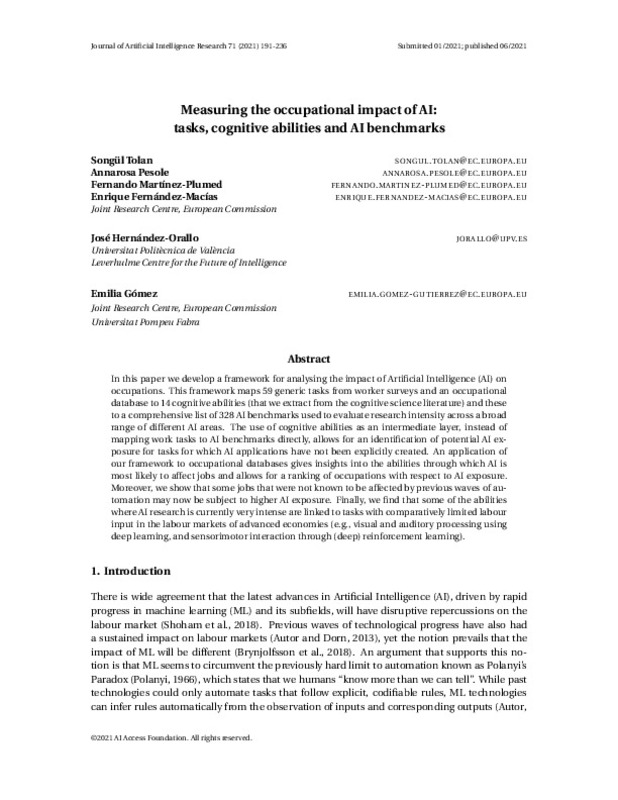JavaScript is disabled for your browser. Some features of this site may not work without it.
Buscar en RiuNet
Listar
Mi cuenta
Estadísticas
Ayuda RiuNet
Admin. UPV
Measuring the Occupational Impact of AI: Tasks, Cognitive Abilities and AI Benchmarks
Mostrar el registro sencillo del ítem
Ficheros en el ítem
| dc.contributor.author | Tolan, Songül
|
es_ES |
| dc.contributor.author | Pesole, Annarosa
|
es_ES |
| dc.contributor.author | Martínez-Plumed, Fernando
|
es_ES |
| dc.contributor.author | Fernández-Macías, Enrique
|
es_ES |
| dc.contributor.author | Hernández-Orallo, José
|
es_ES |
| dc.contributor.author | Gómez, Emilia
|
es_ES |
| dc.date.accessioned | 2022-09-26T18:02:47Z | |
| dc.date.available | 2022-09-26T18:02:47Z | |
| dc.date.issued | 2021-06-09 | es_ES |
| dc.identifier.issn | 1076-9757 | es_ES |
| dc.identifier.uri | http://hdl.handle.net/10251/186577 | |
| dc.description.abstract | [EN] In this paper we develop a framework for analysing the impact of Artificial Intelligence (AI) on occupations. This framework maps 59 generic tasks from worker surveys and an occupational database to 14 cognitive abilities (that we extract from the cognitive science literature) and these to a comprehensive list of 328 AI benchmarks used to evaluate research intensity across a broad range of different AI areas. The use of cognitive abilities as an intermediate layer, instead of mapping work tasks to AI benchmarks directly, allows for an identification of potential AI exposure for tasks for which AI applications have not been explicitly created. An application of our framework to occupational databases gives insights into the abilities through which AI is most likely to affect jobs and allows for a ranking of occupations with respect to AI exposure. Moreover, we show that some jobs that were not known to be affected by previous waves of automation may now be subject to higher AI exposure. Finally, we find that some of the abilities where AI research is currently very intense are linked to tasks with comparatively limited labour input in the labour markets of advanced economies (e.g., visual and auditory processing using deep learning, and sensorimotor interaction through (deep) reinforcement learning). | es_ES |
| dc.language | Inglés | es_ES |
| dc.publisher | AI Access Foundation | es_ES |
| dc.relation.ispartof | Journal of Artificial Intelligence Research | es_ES |
| dc.rights | Reconocimiento - No comercial - Sin obra derivada (by-nc-nd) | es_ES |
| dc.subject.classification | LENGUAJES Y SISTEMAS INFORMATICOS | es_ES |
| dc.title | Measuring the Occupational Impact of AI: Tasks, Cognitive Abilities and AI Benchmarks | es_ES |
| dc.type | Artículo | es_ES |
| dc.identifier.doi | 10.1613/jair.1.12647 | es_ES |
| dc.rights.accessRights | Abierto | es_ES |
| dc.contributor.affiliation | Universitat Politècnica de València. Departamento de Sistemas Informáticos y Computación - Departament de Sistemes Informàtics i Computació | es_ES |
| dc.description.bibliographicCitation | Tolan, S.; Pesole, A.; Martínez-Plumed, F.; Fernández-Macías, E.; Hernández-Orallo, J.; Gómez, E. (2021). Measuring the Occupational Impact of AI: Tasks, Cognitive Abilities and AI Benchmarks. Journal of Artificial Intelligence Research. 71:191-236. https://doi.org/10.1613/jair.1.12647 | es_ES |
| dc.description.accrualMethod | S | es_ES |
| dc.relation.publisherversion | https://doi.org/10.1613/jair.1.12647 | es_ES |
| dc.description.upvformatpinicio | 191 | es_ES |
| dc.description.upvformatpfin | 236 | es_ES |
| dc.type.version | info:eu-repo/semantics/publishedVersion | es_ES |
| dc.description.volume | 71 | es_ES |
| dc.relation.pasarela | S\460572 | es_ES |








